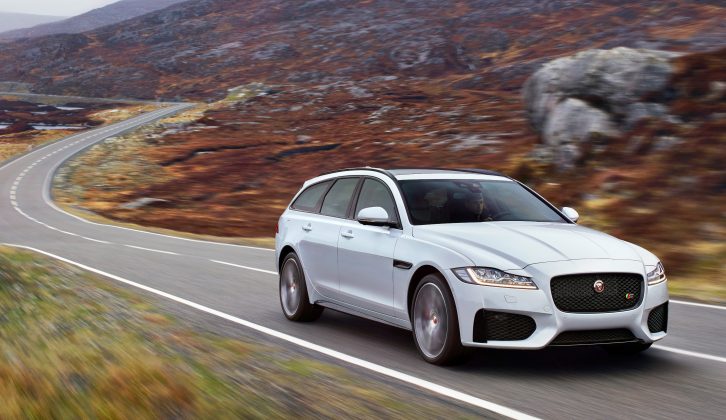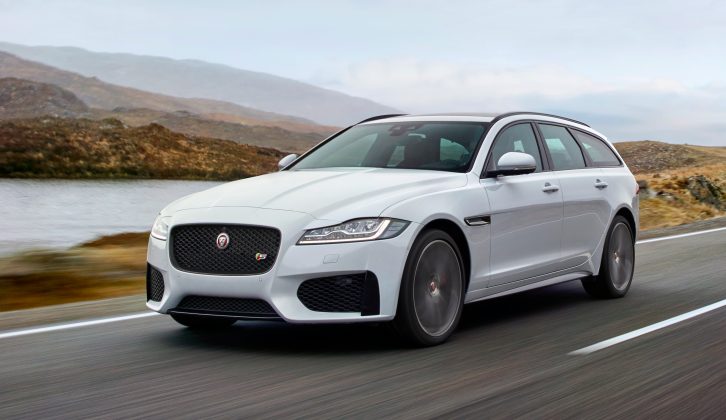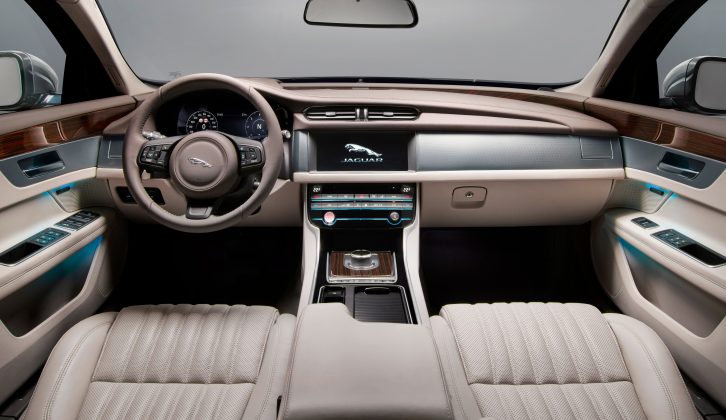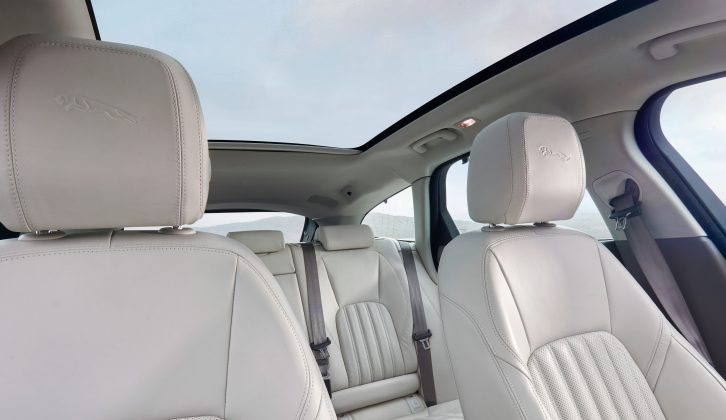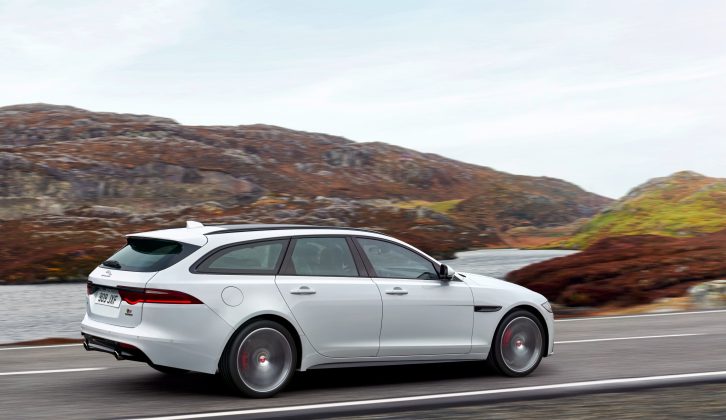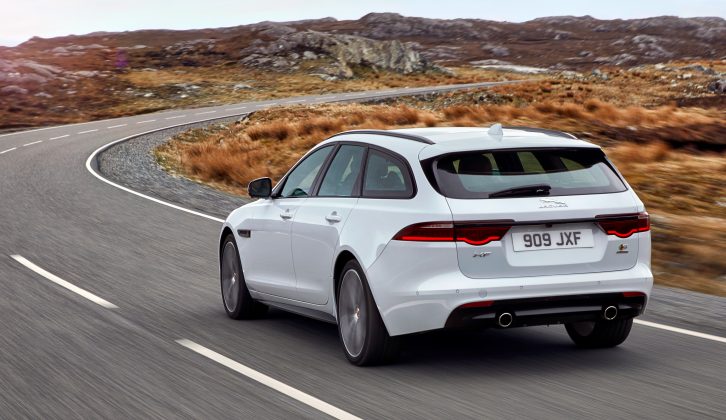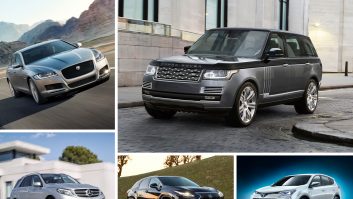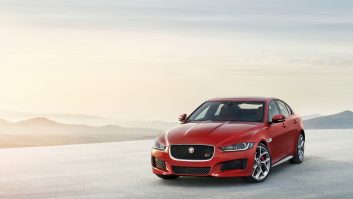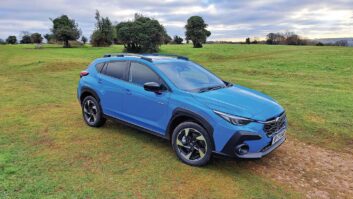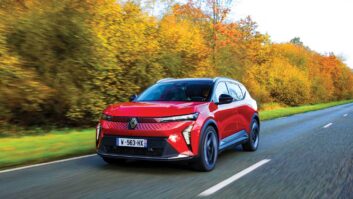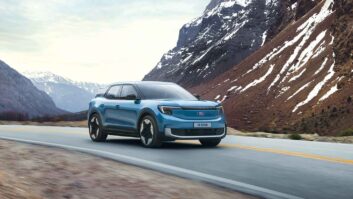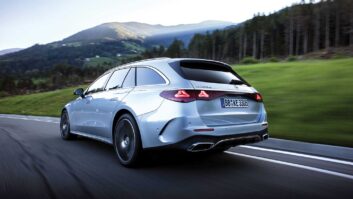With the growth in SUV sales showing no sign of stopping, do buyers still want big estate cars like the Jaguar XF Sportbrake?
Jaguar argues that at least some do. In fact, the company’s own figures predict an increase in global sales for large, upmarket estates like the Sportbrake.
That’s good news for caravanners, as the old Sportbrake made an excellent tow car.
We haven’t had the chance to tow with the Jaguar XF Sportbrake yet, but first impressions are promising.
The 2.0-litre petrol
If you’re feeling sensible, there’s a choice of 2.0-litre diesel engines with 161bhp, 168bhp, or 237bhp. There’s also a 2.0-litre petrol.
Let’s talk about the petrol first. It puts out 247bhp and 269lb ft of torque, enough to row along at a decent pace – Jaguar quotes a 0-60mph time of 7.1 seconds.
Despite the high peak torque figure it does need to be revved hard to make the most of its power. That’s no great hardship, though, when this is an impressively refined engine for a four-cylinder unit.
How well would the petrol XF tow? Well, the 1705kg kerbweight gives an 85% match figure of 1449kg, comfortably inside the 1900kg legal towing limit. The maximum download on the towball is 100kg.
There’s enough mid-range to comfortably tow a caravan of that weight, but the automatic gearbox in the petrol car did change down more frequently than the ‘box in either of the diesels.
It may well hunt around somewhat when towing a heavy caravan.
What about the diesel?
So what tow car potential does the 2.0-litre diesel have? For frequent towing, it seems to have more going for it, at least in 237bhp form.
This is the diesel we tested and it has a lot more torque for a start, some 369lb ft of the stuff.
With extra mid-range muscle, the gearbox has less work to do on hilly roads, which should make for a more relaxed towing experience.
The diesel is more economical, too. Despite being four-wheel drive whereas the petrol we drove was rear-wheel drive, its 48.7mpg official combined figure comfortably beats the petrol’s 41.5mpg.
The extra weight of the four-wheel-drive transmission helps push the kerbweight up to 1805kg. That makes for an 85% match of 1534kg, well inside the 2000kg legal towing limit.
Need yet more performance?
Feeling less sensible?
Few owners really need more performance than the 237bhp diesel offers, but if you want to keep a lid on how much you spend I suggest you don’t test drive the 3.0-litre diesel.
While the 2.0-litre diesel is reasonably quiet and refined, the six-cylinder diesel has the character the 2.0-litre engine lacks.
It sounds smoother and more tuneful, and offers considerably more punch, too. Power jumps up to 296bhp and torque to 516lb ft.
The same engine helped the F-Pace to a class win in the 2017 Tow Car Awards, and it’s every bit as effective in the XF.
In fact, with better aerodynamics and less weight to haul, performance is even better.
Of course, straight line speed matters little compared with stability while towing.
The XF saloon has proven itself a very stable tow car (another Tow Car Awards class winner), so Jaguar’s chassis engineers would have to have made some very perverse choices to make the Sportbrake tow worse than the saloon.
In fact, it should tow better, especially when heavily loaded, thanks to the addition of self-levelling air suspension at the rear.
Practical and rewarding
In solo driving, the Jaguar XF is very rewarding. It’s a neat trick to be so supple over bumps but so well controlled at speed.
It’s a big car, and you’re sometimes aware of its considerable heft in tight corners. But thanks in no small part to precise and feelsome steering, it’s a thoroughly enjoyable car to drive.
It makes a good estate car, too. The total load capacity with the seats upright is 565 litres, matching an Audi A6 Avant but five litres fewer than a BMW 5 Series Touring.
There’s no load lip and the boot floor is relatively low to the ground, a definite plus with an estate compared with an SUV like the F-Pace.
Fold the seats down using levers either side of the tailgate and you are left with an all-but flat load floor, and a total capacity of 1700 litres.
However, if you need more space for your holiday luggage a Mercedes-Benz E-Class Estate is much roomier seats up (640 litres) or down (1820 litres).
Comfortable and spacious
It’s a similar story inside, with decent but not class-leading space.
Adults should be reasonably comfortable in the back, but the transmission tunnel is huge and means the XF seats two in the back more ably than three.
Up front, the driving position gave us no aches and pains at the end of a long day behind the wheel, and the Jaguar is solidly made.
However, it can’t match the showroom appeal and upmarket finish of an Audi A6 or a Mercedes-Benz E-Class.
There’s a choice of trim levels. The Jaguar XF Sportbrake range starts with Prestige, then there’s Portfolio, then R-Sport. The 3.0-litre diesel comes in range-topping ‘S’ specification.
Even Prestige cars are reasonably equipped, with an eight-inch touchscreen, an auto-dimming rear-view mirror, Bluetooth connectivity and streaming, a DAB radio, autonomous emergency braking, leather upholstery and heated front seats. Prices start from £34,910.
So, if you’re prepared to swim against the tide and choose an estate car rather than an SUV, the Jaguar XF Sportbrake is a practical, handsome and fine-driving alternative.
It's a neat trick to be so supple over bumps but so well controlled at speed
